English Email Greeting
- 格式:docx
- 大小:13.05 KB
- 文档页数:2
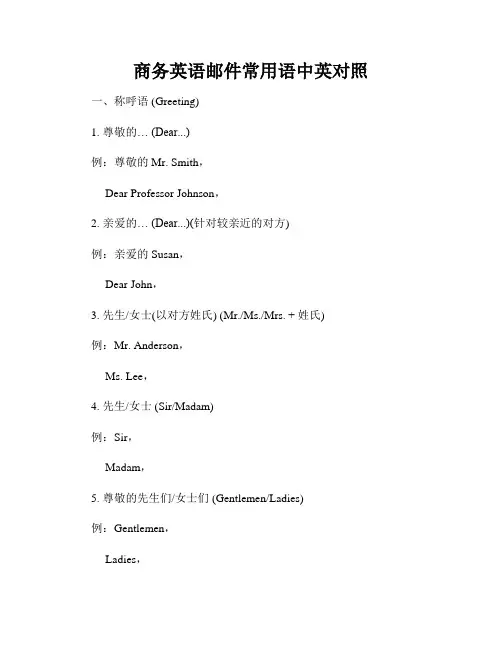
商务英语邮件常用语中英对照一、称呼语 (Greeting)1. 尊敬的… (Dear...)例:尊敬的Mr. Smith,Dear Professor Johnson,2. 亲爱的… (Dear...)(针对较亲近的对方)例:亲爱的Susan,Dear John,3. 先生/女士(以对方姓氏) (Mr./Ms./Mrs. + 姓氏)例:Mr. Anderson,Ms. Lee,4. 先生/女士 (Sir/Madam)例:Sir,Madam,5. 尊敬的先生们/女士们 (Gentlemen/Ladies)例:Gentlemen,Ladies,6. 美好的一天 (Good day)例:Good day,7. 你好 (Hello)例:Hello,二、引言 (Introduction)1. 我写信是因为... (I am writing to...)例:I am writing to inquire about...I am writing to confirm the details of...2. 我写信是要告知您... (I am writing to inform you...)例:I am writing to inform you that the shipment has been delayed...I am writing to inform you of the change in schedule...3. 请问您是否能... (I would like to ask if you could...)例:I would like to ask if you could provide me with more information...I would like to ask if you could extend the deadline...4. 非常感谢您的... (Thank you for...)例:Thank you for your prompt response...Thank you for your attention to this matter...三、表达意图 (Stating the Purpose)1. 我想要... (I would like to...)例:I would like to schedule a meeting with you...I would like to request a quotation for the products...2. 我需要... (I need...)例:I need your assistance with the project...I need to reschedule the appointment...3. 我希望能得到... (I would appreciate it if...)例:I would appreciate it if you could send me the contract by tomorrow...I would appreciate it if you could provide me with the necessary documents...四、解释和询问 (Explanation and Inquiry)1. 由于... (Due to...)例:Due to unforeseen circumstances, we have to cancel the event...Due to a technical issue, the website is currently not accessible...2. 是否可能... (Is it possible...)例:Is it possible to receive a refund for the damaged goods?Is it possible to schedule a conference call to discuss the project?3. 请您确认... (Could you please confirm...)例:Could you please confirm the delivery date?Could you please confirm the total cost of the order?五、给予回应 (Response)1. 我们会尽快处理... (We will process...)例:We will process your request and get back to you as soon as possible...We will process the payment and send you a confirmation email...2. 抱歉给您带来不便 (Apologies for the inconvenience caused)例:Apologies for the inconvenience caused. We are working to resolve the issue...We sincerely apologize for the delay in response...3. 确认收到 (Confirming receipt)例:I confirm that I have received the documents...We acknowledge receipt of your email...六、结束语 (Closing)1. 谢谢您的理解和合作 (Thank you for your understanding and cooperation)例:Thank you for your understanding and cooperation in this matter...We appreciate your understanding and cooperation...2. 如果您有任何问题,请随时与我联系 (If you have any questions, please feel free to contact me)例:If you have any questions, please feel free to contact me at any time...Please do not hesitate to contact me if you have any further inquiries...3. 祝您一切顺利 (Best regards)例:Best regards,Sincerely,以上是商务英语邮件常用语中英对照,希望对您有所帮助。
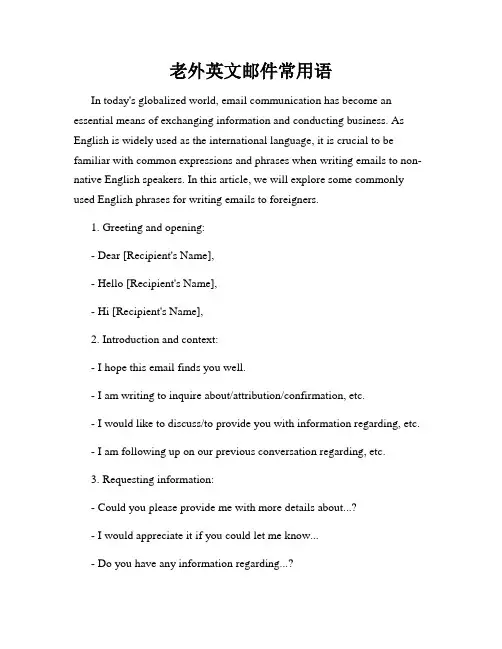
老外英文邮件常用语In today's globalized world, email communication has become an essential means of exchanging information and conducting business. As English is widely used as the international language, it is crucial to be familiar with common expressions and phrases when writing emails to non-native English speakers. In this article, we will explore some commonly used English phrases for writing emails to foreigners.1. Greeting and opening:- Dear [Recipient's Name],- Hello [Recipient's Name],- Hi [Recipient's Name],2. Introduction and context:- I hope this email finds you well.- I am writing to inquire about/attribution/confirmation, etc.- I would like to discuss/to provide you with information regarding, etc.- I am following up on our previous conversation regarding, etc.3. Requesting information:- Could you please provide me with more details about...?- I would appreciate it if you could let me know...- Do you have any information regarding...?- Could you kindly clarify...4. Offering assistance:- If you require any further assistance, please feel free to contact me.- I am at your disposal for any additional information you may need.- Please don't hesitate to reach out if you have any questions.- If there is anything else I can do for you, please let me know.5. Scheduling and coordinating:- I would like to schedule a meeting/conference call at your convenience. - Could we arrange a time to discuss this further?- Please let me know your availability for the proposed date/time.- I look forward to meeting/talking with you on [date] at [time].6. Apologizing and expressing gratitude:- I apologize for any inconvenience caused.- Thank you for your understanding/prompt response/valuable input.- I greatly appreciate your assistance/time/efforts.7. Closing:- Thank you for your attention.- Best regards/Kind regards/Sincerely,- Looking forward to hearing from you.- Have a great day!8. Attaching documents:- Please find attached the file/document.- I have attached the necessary information for your review.- Kindly see the attached document.- The document you requested is attached.Remember to adapt the tone and level of formality according to the recipient and the purpose of your email. It is also important to proofread your email before sending it to ensure clarity and correctness.By incorporating these commonly used English phrases, you will be able to effectively communicate with foreigners via email and create a positive impression in your professional interactions. Practice using these phrases to enhance your English writing skills and build rapport with international contacts.。
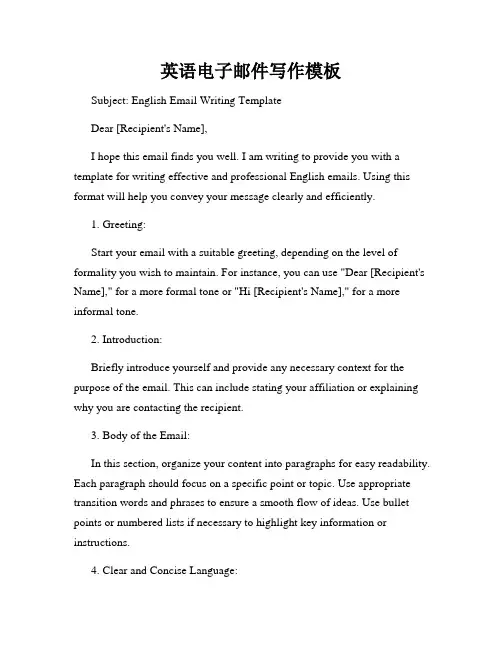
英语电子邮件写作模板Subject: English Email Writing TemplateDear [Recipient's Name],I hope this email finds you well. I am writing to provide you with a template for writing effective and professional English emails. Using this format will help you convey your message clearly and efficiently.1. Greeting:Start your email with a suitable greeting, depending on the level of formality you wish to maintain. For instance, you can use "Dear [Recipient's Name]," for a more formal tone or "Hi [Recipient's Name]," for a more informal tone.2. Introduction:Briefly introduce yourself and provide any necessary context for the purpose of the email. This can include stating your affiliation or explaining why you are contacting the recipient.3. Body of the Email:In this section, organize your content into paragraphs for easy readability. Each paragraph should focus on a specific point or topic. Use appropriate transition words and phrases to ensure a smooth flow of ideas. Use bullet points or numbered lists if necessary to highlight key information or instructions.4. Clear and Concise Language:Avoid using complex vocabulary and sentence structures. Keep your sentences short and to the point. Use simple, clear language to ensure that your message is easily understood by the recipient.5. Politeness and Respect:Maintain a respectful and courteous tone throughout your email. Use phrases such as "Please" and "Thank you" to show appreciation. Avoid using language that may come across as rude or demanding.6. Closing:In the closing section, restate your main purpose or request. If appropriate, provide any necessary follow-up actions or deadlines. End your email with a closing phrase such as "Best regards" or "Sincerely," followed by your name.7. Signature:Include your full name, job title, and contact information (phone number and/or email address) in your email signature. This allows the recipient to easily reach you if they have any questions or need further assistance.Remember to proofread your email for any grammatical or spelling errors before hitting the send button. Taking the time to ensure your email is well-written and error-free will contribute to a positive impression on the recipient.Thank you for your attention, and please let me know if you have any further questions or require any additional information.Best regards,[Your Name][Your Job Title][Your Contact Information]。
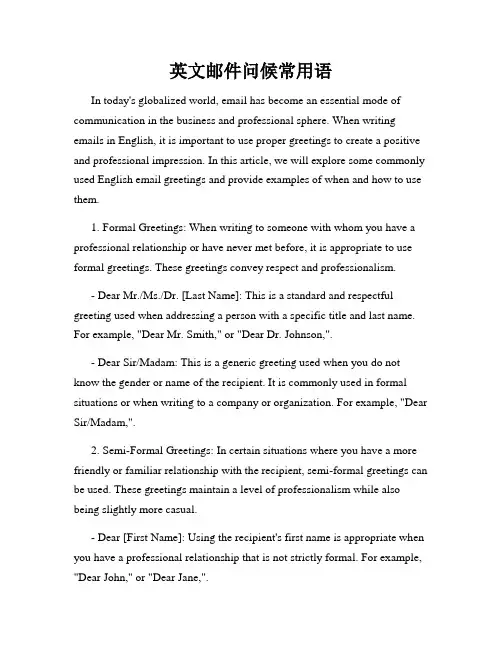
英文邮件问候常用语In today's globalized world, email has become an essential mode of communication in the business and professional sphere. When writing emails in English, it is important to use proper greetings to create a positive and professional impression. In this article, we will explore some commonly used English email greetings and provide examples of when and how to use them.1. Formal Greetings: When writing to someone with whom you have a professional relationship or have never met before, it is appropriate to use formal greetings. These greetings convey respect and professionalism.- Dear Mr./Ms./Dr. [Last Name]: This is a standard and respectful greeting used when addressing a person with a specific title and last name. For example, "Dear Mr. Smith," or "Dear Dr. Johnson,".- Dear Sir/Madam: This is a generic greeting used when you do not know the gender or name of the recipient. It is commonly used in formal situations or when writing to a company or organization. For example, "Dear Sir/Madam,".2. Semi-Formal Greetings: In certain situations where you have a more friendly or familiar relationship with the recipient, semi-formal greetings can be used. These greetings maintain a level of professionalism while also being slightly more casual.- Dear [First Name]: Using the recipient's first name is appropriate when you have a professional relationship that is not strictly formal. For example, "Dear John," or "Dear Jane,".- Hello: This is a friendly and informal greeting that can be used in less formal situations, such as when writing to colleagues or acquaintances. For example, "Hello Tom," or "Hello Emily,".3. Informal Greetings: In very casual or friendly situations, informal greetings can be used. These greetings are reserved for close colleagues, friends, or family members.- Hi [First Name]: This is a common and relaxed greeting used amongst friends or colleagues who have a good rapport. For example, "Hi Alex," or "Hi Sarah,".- Hey [First Name]: This is an even more informal greeting used among very close friends or colleagues. It should be used with caution in professional settings. For example, "Hey Mike," or "Hey Lisa,".4. No Formal Greeting: In certain email exchanges, especially when you are responding to a previous email, it is acceptable to omit a formal greeting and go straight into the body of the email. This is particularly common in quick exchanges or when writing to someone with whom you have a close relationship.- Hi [First Name], or Hello [First Name],: These concise greetings can be used when you want to start the email without a formal introduction. For example, "Hi Kate," or "Hello David,".It's important to note that the choice of greeting may also depend on cultural norms or the specific recipient's preferences. When in doubt, it is always best to err on the side of formality and choose a more formal greeting.In conclusion, using appropriate greetings in English emails is crucial for maintaining a professional and respectful tone. Whether you use formal, semi-formal, or informal greetings depends on the nature of your relationship with the recipient. By following the guidelines outlined in this article, you can ensure that your emails are well-received and effectively convey your message.。
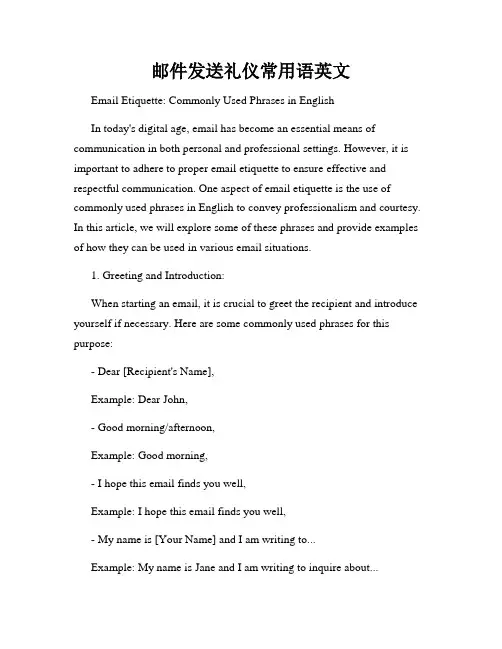
邮件发送礼仪常用语英文Email Etiquette: Commonly Used Phrases in EnglishIn today's digital age, email has become an essential means of communication in both personal and professional settings. However, it is important to adhere to proper email etiquette to ensure effective and respectful communication. One aspect of email etiquette is the use of commonly used phrases in English to convey professionalism and courtesy. In this article, we will explore some of these phrases and provide examples of how they can be used in various email situations.1. Greeting and Introduction:When starting an email, it is crucial to greet the recipient and introduce yourself if necessary. Here are some commonly used phrases for this purpose:- Dear [Recipient's Name],Example: Dear John,- Good morning/afternoon,Example: Good morning,- I hope this email finds you well,Example: I hope this email finds you well,- My name is [Your Name] and I am writing to...Example: My name is Jane and I am writing to inquire about...2. Requesting Information or Assistance:When asking for information or assistance in an email, it is essential to be polite and clear. Here are some phrases that can be helpful:- I would appreciate it if you could...Example: I would appreciate it if you could provide me with more details about...- Could you please...Example: Could you please assist me with...- I am writing to inquire about...Example: I am writing to inquire about the status of...- Please let me know at your earliest convenience...Example: Please let me know at your earliest convenience if...3. Responding to Requests:When responding to an email requesting information or assistance, it is important to be prompt and courteous. Here are some phrases that can be used in such situations:- Thank you for reaching out to me. Here is the information you requested...Example: Thank you for reaching out to me. Here is the information you requested.- I have attached the requested documents...Example: I have attached the requested documents for your reference.- I apologize for any inconvenience caused. Unfortunately, I am unable to...Example: I apologize for any inconvenience caused. Unfortunately, I am unable to assist with...- Thank you for your patience. I will get back to you as soon as possible with the requested information...Example: Thank you for your patience. I will get back to you as soon as possible with the requested information.4. Expressing Gratitude:Showing gratitude in an email goes a long way in maintaining good relationships. Here are some phrases to express gratitude:- Thank you for your prompt response...Example: Thank you for your prompt response.- I appreciate your assistance with...Example: I appreciate your assistance with...- Your support is greatly appreciated...Example: Your support is greatly appreciated.- Thank you in advance for your cooperation...Example: Thank you in advance for your cooperation.5. Closing Remarks:When ending an email, it is important to leave a positive and professional impression. Here are some closing phrases that can be used:- Thank you again for your time and attention to this matter...Example: Thank you again for your time and attention to this matter.- I look forward to hearing from you soon...Example: I look forward to hearing from you soon.- Please do not hesitate to contact me if you have any further questions...Example: Please do not hesitate to contact me if you have any further questions.- Best regards,Example: Best regards,Remember, using appropriate and polite language is key to effective email communication. By incorporating these commonly used phrases in your emails, you can convey respect and professionalism, leading to smoother and more productive conversations.。
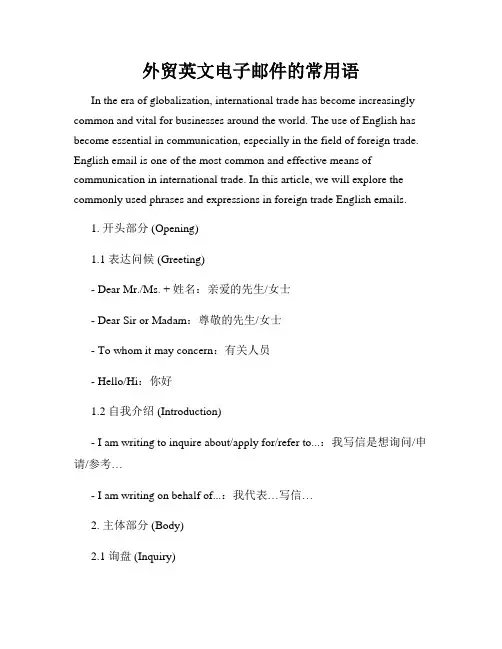
外贸英文电子邮件的常用语In the era of globalization, international trade has become increasingly common and vital for businesses around the world. The use of English has become essential in communication, especially in the field of foreign trade. English email is one of the most common and effective means of communication in international trade. In this article, we will explore the commonly used phrases and expressions in foreign trade English emails.1. 开头部分 (Opening)1.1 表达问候 (Greeting)- Dear Mr./Ms. + 姓名:亲爱的先生/女士- Dear Sir or Madam:尊敬的先生/女士- To whom it may concern:有关人员- Hello/Hi:你好1.2 自我介绍 (Introduction)- I am writing to inquire about/apply for/refer to...:我写信是想询问/申请/参考…- I am writing on behalf of...:我代表…写信…2. 主体部分 (Body)2.1 询盘 (Inquiry)- We are interested in your product/service. Could you please provide us with...?:我们对贵公司的产品/服务感兴趣。
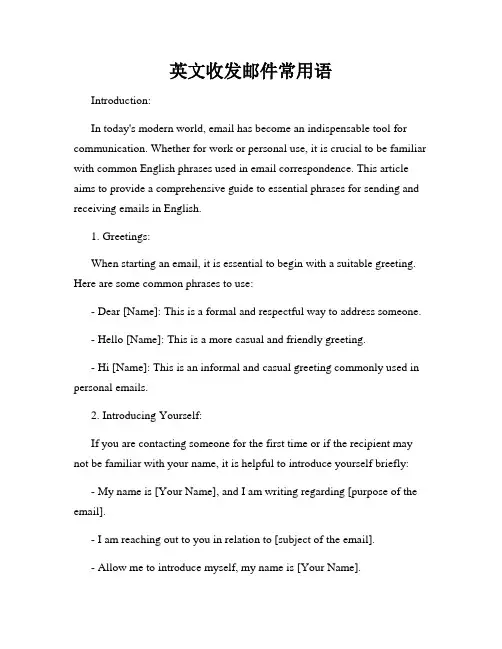
英文收发邮件常用语Introduction:In today's modern world, email has become an indispensable tool for communication. Whether for work or personal use, it is crucial to be familiar with common English phrases used in email correspondence. This article aims to provide a comprehensive guide to essential phrases for sending and receiving emails in English.1. Greetings:When starting an email, it is essential to begin with a suitable greeting. Here are some common phrases to use:- Dear [Name]: This is a formal and respectful way to address someone.- Hello [Name]: This is a more casual and friendly greeting.- Hi [Name]: This is an informal and casual greeting commonly used in personal emails.2. Introducing Yourself:If you are contacting someone for the first time or if the recipient may not be familiar with your name, it is helpful to introduce yourself briefly:- My name is [Your Name], and I am writing regarding [purpose of the email].- I am reaching out to you in relation to [subject of the email].- Allow me to introduce myself, my name is [Your Name].3. Requesting Information:When seeking information or clarification in an email, it is crucial to use polite and clear language:- I would appreciate it if you could provide me with [specific information you need].- Could you please let me know [requested information]?- I am writing to inquire about [the topic or issue you want to know more about].- I was wondering if you could assist me with [specific request].4. Offering Assistance:If you want to offer your help or support in an email, you can use these phrases:- Please let me know if there is anything I can do to assist you.- If you require any further help, feel free to reach out to me.- I am at your disposal if you need any further information.- Should you need any assistance, please do not hesitate to ask.5. Confirming Information:When confirming details or ensuring that both parties are on the same page, you can use the following phrases:- I just wanted to confirm that [restate the specific details].- Just to clarify, [repeat the information you want to confirm].- Could you please verify that [specific details]?- Please let me know if my understanding is correct: [reiterate the details].6. Apologizing:If you need to apologize in an email, these phrases can be helpful:- I apologize for any inconvenience caused by [the issue or mistake].- I am sorry for the misunderstanding and any confusion it may have caused.- Please accept my apologies for [the error or misunderstanding].- I would like to extend my sincere apologies for any trouble caused by [the situation].7. Closing:When concluding an email, consider using these phrases:- Thank you for your attention and prompt response.- I look forward to receiving your reply at your earliest convenience.- Should you have any further questions, please feel free to ask.- Thank you for your time and assistance in this matter.Conclusion:Mastering the art of email communication involves using appropriate and effective language. With the phrases provided in this article, you can confidently send and respond to emails in English, ensuring clear communication and successful interactions. Remember to adapt the language according to the level of formality and the relationship you have with the recipient. Happy emailing!。
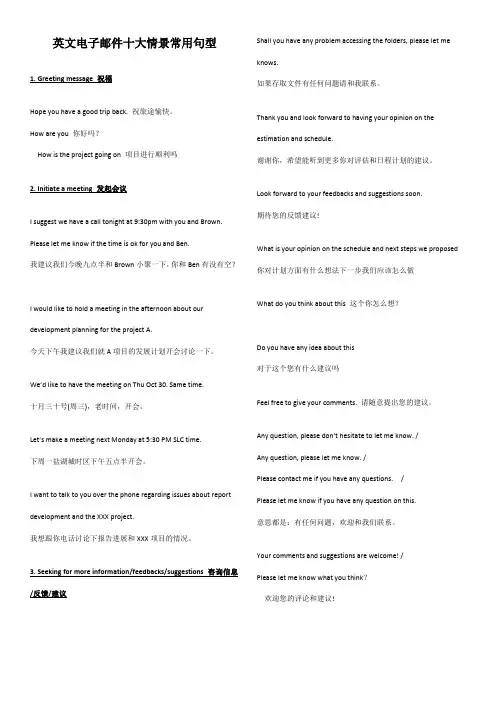
英文电子邮件十大情景常用句型1. Greeting message 祝福Hope you have a good trip back. 祝旅途愉快。
How are you 你好吗?How is the project going on 项目进行顺利吗2. Initiate a meeting 发起会议I suggest we have a call tonight at 9:30pm with you and Brown. Please let me know if the time is ok for you and Ben.我建议我们今晚九点半和Brown小聚一下,你和Ben有没有空?I would like to hold a meeting in the afternoon about our development planning for the project A.今天下午我建议我们就A项目的发展计划开会讨论一下。
We’d like to have the meeting on Thu Oct 30. Same time.十月三十号(周三),老时间,开会。
L et’s make a meeting next Monday at 5:30 PM SLC time.下周一盐湖城时区下午五点半开会。
I want to talk to you over the phone regarding issues about report development and the XXX project.我想跟你电话讨论下报告进展和XXX项目的情况。
3. Seeking for more information/feedbacks/suggestions 咨询信息/反馈/建议Shall you have any problem accessing the folders, please let me knows.如果存取文件有任何问题请和我联系。
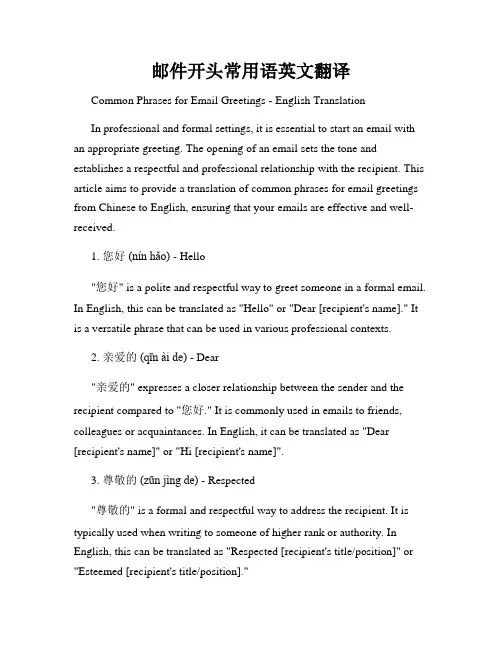
邮件开头常用语英文翻译Common Phrases for Email Greetings - English TranslationIn professional and formal settings, it is essential to start an email with an appropriate greeting. The opening of an email sets the tone and establishes a respectful and professional relationship with the recipient. This article aims to provide a translation of common phrases for email greetings from Chinese to English, ensuring that your emails are effective and well-received.1. 您好(nín hǎo) - Hello"您好" is a polite and respectful way to greet someone in a formal email. In English, this can be translated as "Hello" or "Dear [recipient's name]." It is a versatile phrase that can be used in various professional contexts.2. 亲爱的(qīn ài de) - Dear"亲爱的" expresses a closer relationship between the sender and the recipient compared to "您好." It is commonly used in emails to friends, colleagues or acquaintances. In English, it can be translated as "Dear [recipient's name]" or "Hi [recipient's name]".3. 尊敬的(zūn jìng de) - Respected"尊敬的" is a formal and respectful way to address the recipient. It is typically used when writing to someone of higher rank or authority. In English, this can be translated as "Respected [recipient's title/position]" or "Esteemed [recipient's title/position]."4. 敬礼(jìng lǐ) - Salutations"敬礼" is commonly used in military or official emails to show respect and admiration. In English, it can be translated as "Salutations" or "Greetings." This phrase is generally reserved for more formal and official correspondences.5. 你好(nǐ hǎo) - Hi"你好" is a friendly and informal way to greet someone in an email. It can be used when writing to colleagues or acquaintances in a casual setting. In English, this can be translated as "Hi" or "Hello."6. 问候 (wèn hòu) - Greetings"问候" is a simple and general way to greet someone in an email. In English, this can be translated as "Greetings" or "Hello." It is appropriate for both formal and informal correspondences.7. 大家好(dà jiā hǎo) - Hello everyone"大家好" is commonly used as a greeting when writing to a group of people in an email. In English, this can be translated as "Hello everyone" or "Hi everyone." It creates a warm and inclusive tone in the email.8. 早上好(zǎo shàng hǎo) - Good morning"早上好" is a specific greeting used in the morning. In English, this can be translated as "Good morning" or "Morning." It is appropriate for both formal and informal emails sent during the morning hours.9. 下午好(xià wǔ hǎo) - Good afternoon"下午好" is a specific greeting used in the afternoon. In English, this can be translated as "Good afternoon" or "Afternoon." It is suitable for both formal and informal emails sent during the afternoon hours.10. 晚上好(wǎn shàng hǎo) - Good evening"晚上好" is a specific greeting used in the evening. In English, this can be translated as "Good evening" or "Evening." It is appropriate for both formal and informal emails sent during the evening hours.In conclusion, the appropriate email greeting sets the tone for effective communication. By understanding the translation of common email greetings from Chinese to English, you can tailor your emails to the professional context and establish a positive relationship with the recipient. Remember to choose the appropriate greeting based on the formality of the email and your relationship with the recipient. Happy emailing!。
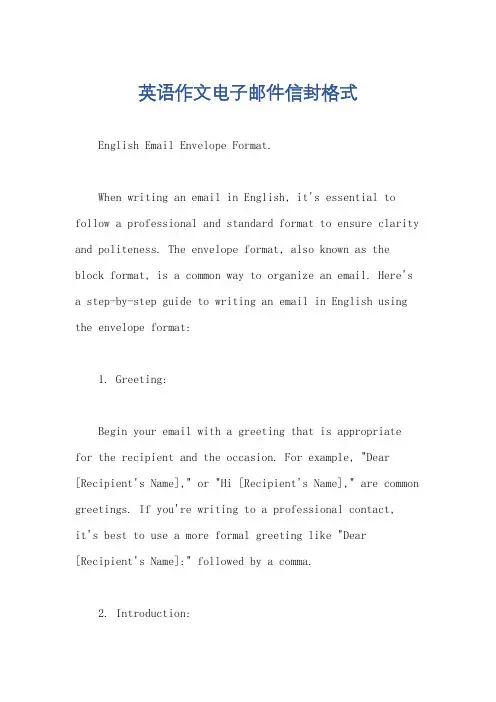
英语作文电子邮件信封格式English Email Envelope Format.When writing an email in English, it's essential to follow a professional and standard format to ensure clarity and politeness. The envelope format, also known as the block format, is a common way to organize an email. Here's a step-by-step guide to writing an email in English using the envelope format:1. Greeting:Begin your email with a greeting that is appropriatefor the recipient and the occasion. For example, "Dear [Recipient's Name]," or "Hi [Recipient's Name]," are common greetings. If you're writing to a professional contact,it's best to use a more formal greeting like "Dear [Recipient's Name]:" followed by a comma.2. Introduction:In the introduction, briefly introduce the purpose of your email. This could be a request for information, a response to a previous email, or an update on a project.It's important to be clear and concise so that therecipient knows what to expect from your email.3. Body:The body of your email should contain the main content of your message. Here, you can provide details, ask questions, or share information. Use paragraphs to organize your thoughts and make it easier for the recipient to read and understand your email.When writing in English, it's important to use clear and simple language. Avoid using complex sentences or jargon that may be unfamiliar to the recipient. Also, be mindful of grammar and spelling mistakes, as they canaffect the readability and professionalism of your email.4. Conclusion:In the conclusion, summarize your email and provide any final thoughts or requests. If you're making a request, be sure to thank the recipient for their time and assistance. If you're responding to a previous email, it's helpful to refer back to that email and acknowledge the recipient's previous comments or requests.5. Closing:End your email with a closing that is appropriate for the recipient and the occasion. Common closings include "Best regards," "Thank you," or simply "Best," followed by your name. If you're writing to a professional contact,it's best to use a more formal closing like "Sincerely," or "Best regards," followed by your full name.6. Signature:Include your contact information at the end of your email, such as your name, title (if applicable), company name, and contact details. This allows the recipient toeasily get in touch with you if needed.Remember to proofread your email before sending it to ensure it's free of grammar and spelling mistakes. Also, be mindful of the tone and language you use to ensure it's appropriate for the recipient and the occasion.Here's an example of an email written in the envelope format:Subject: Request for Information.Dear Mr. Smith,。
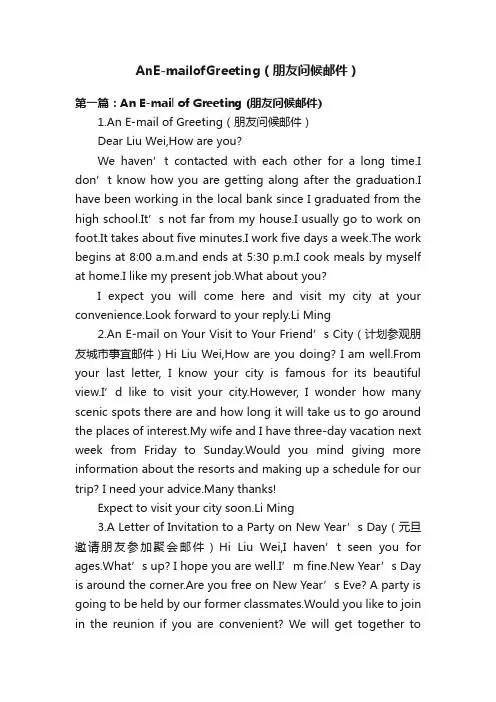
AnE-mailofGreeting(朋友问候邮件)第一篇:An E-mail of Greeting (朋友问候邮件)1.An E-mail of Greeting(朋友问候邮件)Dear Liu Wei,How are you?We haven’t contacted with each other for a long time.I don’t know how you are getting along after the graduation.I have been working in the local bank since I graduated from the high school.It’s not far from my house.I usually go to work on foot.It takes about five minutes.I work five days a week.The work begins at 8:00 a.m.and ends at 5:30 p.m.I cook meals by myself at home.I like my present job.What about you?I expect you will come here and visit my city at your convenience.Look forward to your reply.Li Ming2.An E-mail on Your Visit to Your Friend’s City(计划参观朋友城市事宜邮件)Hi Liu Wei,How are you doing? I am well.From your last letter, I know your city is famous for its beautiful view.I’d like to visit your city.However, I wonder how many scenic spots there are and how long it will take us to go around the places of interest.My wife and I have three-day vacation next week from Friday to Sunday.Would you mind giving more information about the resorts and making up a schedule for our trip? I need your advice.Many thanks!Expect to visit your city soon.Li Ming3.A Letter of Invi tation to a Party on New Year’s Day(元旦邀请朋友参加聚会邮件)Hi Liu Wei,I haven’t seen you for ages.What’s up? I hope you are well.I’m fine.New Year’s Day is around the corner.Are you free on New Year’s Eve? A party is going to be held by our former classmates.Would you like to join in the reunion if you are convenient? We will get together tocelebrate the beginning of New Year and have a chat about our recent life and future plan.There will be a lot of entertainment activities such as Karaoke, playing cards, dance and so on.Besides, a variety of delicious food is served at the party.Anticipating your coming.Best regardsLi Ming4.An E-mail of Communicating on English Study(交流英语学习邮件)Hi Liu Wei,How are you? Does everything go well with you?I am fine.I continue to lear n English.I’m good at English writing but I have some difficulty in English speaking.I can’t express myself in ually I go to the English corner during weekends.In fact I find nothing to say there.I really worry about my spoken English very much.However there is no better way I know to improve it.I hear you do well in English.Would you mind telling me about your experience in enhancing spoken English.Thanks!Best wishes.Li Ming5.A Letter of Your recent life(有关最近生活情况信件)Hi Liu Wei,Thanks for your last letter.How are you? Anything new?I’m getting on well with English study, especially my spoken English has made progress according to the way provided by you.I’m really grateful.In the process of English study, I also find the grammar very important.Good grammar will have good effect on other English skills.I’m therefore determined to make efforts to improve English grammar.Do you what kind of grammar book is right for me at my level? Would you mind helping me choose one? Thanks a lot.Li Ming6.A Letter about the English exam of Band four(有关大学英语四级考试信件)Hi Liu Wei,How are you these days? I am busy because I have to make preparation for English exam of Band Four.I really feel worried.Sometimes I even don’t know how to make full use of the short period of time.Would you like to give me any advice on the ways of preparing and some reference books I need to use for the exam? You told me good preparation is very important and you are ready to share with me the experience.I appreciate your help and kindness.It would be very useful and helpful.Li Ming7.家乡的变化I live in a small city.It lies in the southeast of Zhejiang province, China.In the past five years, great changes have taken place in my hometown.One hundred new homes have been living here.In the center stands a splendid statue.In addition, a new hospital is under the construction.The local government has also made new parking regulations with the increasing number of private cars in the city.Moreover, the old blocks of flats are therefore decreasing day by day.8、我业余的学习生活I am studying in Linhai Radio &TV University.It lies in the southeast of Zhejiang Province.的业变化).I only come to the class on weekends, for I have to work from Monday to Friday.The teachers give us face-to-face lectures every two weeks.Besides, I can use computer to learn in my spare time.For example, we can ask teachers for help through E-mail if we have any question.In my opinion, online learning is of great use.My class is a big one with over 80 students.We usually help and get on well with each other.9、应用文:通知通知是传达信息、布置工作、召开会议所使用的一种常见应用文体。
英文邮件常用问候语I hope my email finds you well. 希望我的邮件发现您一切都好。
I hope you enjoy you night and morning! 希望您每天都开开心心。
Sincere wishes to you and I hope you have a good lunch! 美好的祝愿送给您,希望您午餐愉快。
I tried to rich you couple of time on the phone without success. 我试图给您打电话,但是没有成功。
I hope you had a good weekend and businesses are still running. 希望您周末愉快,生意兴隆! It is Ameir greeting you from Shhenzhen. How is going? Ameir从深圳送来问候,最近进展如何? Any comments from you are appreciated! 从您那里得到任何信息我们都将不胜感激! All the staff of our company show our warmest welcome to you for your coming! 我们公司的所有员工热烈欢迎您的到来。
Have a nice day and give my best wishes to you. 美好的一天送上我最美好的祝福。
Thanks for all and waiting your reply we will send you our best regards. 感谢您所作的一切,等待您的答复,送上我最美好的祝福。
How is it going? 过得怎么样呀? How do you do ?还好吗? How are you?您好吗? Do everything well? 一切都顺利吧? I miss you very much,are you happy? How is it going? 过得怎么样呀? How do you do ?还好吗? How are you?您好吗? Do everything well? 一切都顺利吧? I miss you very much,are you happy? How is it going? 过得怎么样呀? How do you do ?还好吗? How are you?您好吗? Do everything well? 一切都顺利吧? I miss you very much,are you happy.。
英语二小作文邮件格式English: When writing an informal email in English, it is important to start with a friendly greeting such as “Hi” or “Hello” followed by the recipient's name. It is common to include some small talk or ask about the recipient’s well-being before getting into the main purpose of the email. In the body of the email, be clear and concise with your message, and make sure to use appropriate language and tone depending on your relationship with the recipient. It is also a good idea to include clo sing remarks such as “Looking forward to hearing from you” or “Take care”. Finally, end the email with a closing like “Best regards” or “Sincerely” followed by your name.中文翻译: 在用英语写非正式邮件时,重要的是要以友好的问候开头,比如“嗨”或“你好”,然后跟上收件人的名字。
在开始谈论邮件主题之前,通常要进行一些闲聊或询问收件人的近况。
在邮件正文中,要清晰简洁地表达你的信息,并根据你与收件人的关系使用适当的语言和语气。
此外,最好在邮件中包含结束语,如“期待你的回复”或“多保重”。
英语邮件寒暄语Dear [Recipient's Name],I hope this email finds you well. I am writing to extend my warm greetings and initiate a conversation on the given topic. As the world becomes increasingly interconnected, communicating in English has become an essential skill for individuals from diverse backgrounds. In this email, I aim to explore the art of English email greetings and provide some useful phrases for different situations.1. Formal Greetings:When emailing someone for the first time or corresponding with a person of higher authority or professional standing, it is crucial to use appropriate formal greetings. Some common phrases include:- "Dear [Recipient's Name]," for more personal relationships in a professional context.- "Dear Mr./Ms./Dr./Professor [Last Name]," when addressing someone with a specific professional title.- "To whom it may concern," when unsure of the recipient's name.2. Informal Greetings:For more casual or informal email exchanges with colleagues, friends, or acquaintances, a relaxed tone can be applied. Here are a few suitable greetings:- "Hi [Recipient's Name]," for more casual relationships.- "Hello [Recipient's Name]," for a friendly yet respectful tone.- "Hey [Recipient's Name]," for a more informal and familiar approach (use with caution).3. Greetings in Response to Email:When responding to an email, it is customary to acknowledge the previous correspondence before proceeding with the main message. This helps maintain a polite and considerate conversation flow. Here are a few appropriate phrases:- "Thank you for your email."- "I appreciate your prompt response."- "In response to your inquiry/question/request..."4. Greetings for Professional Networking:When initiating or maintaining professional connections, paying attention to the email's subject line and body is crucial. A well-crafted subject line helps grab attention, while a polite and engaging greeting sets the tone for a successful interaction. Some examples include:- "Glad to connect with you!"- "Following up on our conversation at [Event/Place]."- "Interested in collaborating on [Common Interest/Project]."5. Greetings for Business Prospects:When reaching out to potential business partners, clients, or employers, a strong and confident greeting can make a lasting impression. Alongside a concise and engaging email body, the greeting should be professional and personalized. Here are a few examples:- "I hope this email finds you well. I would like to introduce myself as..."- "I am writing to inquire about potential opportunities at[Company/Organization]."- "We are impressed with [Company/Organization's] recent achievements and would like to discuss possible collaboration."In conclusion, mastering the art of English email greetings is essential in today's interconnected world. Whether it's a formal or informal email exchange, tailoring your greeting to the specific situation can help create a positive and engaging conversation from the start. Remember to adapt your greetings based on the recipient, maintain a professional tone, and always proofread your emails before sending them.Thank you for your time, and I look forward to hearing from you soon.Best regards,[Your Name]。
英文邮件问候语英文邮件问候语英文邮件问候语I hope my email finds you well.希望我的邮件发现您一切都好。
I hope you enjoy you night and morning!希望您每天都开开心心。
Sincere wishes to you and I hope you have a good lunch!美好的祝愿送给您,希望您午餐愉快。
I tried to rich you couple of time on the phone without success.我试图给您打电话,但是没有成功。
I hope you had a good weekend and businesses are still running.希望您周末愉快,生意兴隆!It is Ameir greeting you from Shhenzhen. How is going?Ameir从深圳送来问候,最近进展如何?Any comments from you are appreciated!从您那里得到任何信息我们都将不胜感激!Can you please confirm if you are available possibly on 23th November, 2006?您能跟我确定在2006年11月23日您是否有空吗?All the staff of our company show our warmest welcome to you for your coming!我们公司的所有员工热烈欢迎您的到来。
Have a nice day and give my best wishes to you.美好的一天送上我最美好的祝福。
Thanks for all and waiting your reply we will send you our best regards.感谢您所作的一切,等待您的答复,送上我最美好的祝福。
英文邮件须知When writing English emails, it is important to keep in mind certain guidelines to ensure effective communication. In this article, we will discuss the key points and considerations to keep in mind when writing English emails.1. Appropriate Greeting and Salutation:Begin the email with a proper greeting, such as "Dear Mr./Ms./Dr. [Last name]" or "Hello [First name]," depending on the recipient's level of formality. Use a comma or colon after the salutation.2. Clear and Concise Subject Line:The subject line should accurately reflect the email's content and purpose. Keep it concise but informative, enabling the recipient to understand at a glance what the email entails.3. Polite and Professional Tone:Maintain a polite and professional tone throughout the email. Use courteous phrases such as "Please" and "Thank you," and avoid using slang, abbreviations, or contractions.4. Structured and Organized Content:Organize the email content into paragraphs or bullet points to enhance readability. Begin with a brief introduction, followed by the main body, and conclude with a concise closing statement.5. Clear and Effective Communication:Ensure your message is clear and to the point. Use simple and precise language, avoiding jargon or technical terms unless necessary. State your purpose clearly and provide any required information or supporting details.6. Proofreading for Grammar and Spelling:Before sending the email, check for any grammar or spelling errors. Read through the email carefully to ensure it is coherent and that there are no typos or punctuation mistakes.7. Proper Use of Attachments:If you need to attach files, ensure they are properly named and relevant to the email's content. Include a clear description of the attached documents or files.8. Professional Email Signature:End the email with a professional signature that includes your full name, job title, and contact details. You may also include a company logo or a link to your website, if appropriate.9. Respect for Privacy and Confidentiality:Respect the recipient's privacy and confidentiality by refraining from sharing sensitive information. If necessary, consider using encryption or password protection for any confidential attachments.10. Timely and Considerate Follow-up:If you are expecting a response or action from the recipient, politely follow up after an appropriate period. Allow sufficient time for the recipient to respond before contacting them again.In conclusion, following these guidelines will help ensure your English emails are concise, professional, and effective. Remember to tailor the tone and style to the recipient, and always proofread your emails before sending them to maintain a positive and respectful impression.。
英文邮件中表达问候的句子1. 英语信件中常用问候语原发布者:芳芳英语中常见的问候语英语中常见的问候语GreetingsareusedtosayhelloinEnglish.It'smontousedifferentgreet ingsdependingonwhetheryougreetafriend,familyorabusinessass ociate.Whenyoumeetfriends,useinformalgreetings.Ifit'sreallyimp ortant,useformalgreetings.Formalgreetingsarealsousedwithpeop leyoudonotknowverywell. 在英语中,问候语被用跟别人打招呼。
根据与你会面的是朋友,家人还是商业伙伴,我们常会使用不同的问候语。
如果确实是在重要的场合,我们会使用正式的问候语。
正式的问候语也可以用于那些不太熟悉的人。
Greetingsalsodependonwhetheryouaresayinghello,oryouaresayi nggoodbye. 在打招呼或者告别的时候,我们使用的问候语也不同。
Learnthecorrectphrasesusingthenotesbelow,andthenpracticeusi nggreetingswiththepracticedialogues. 利用下面的提示,学习正确的短语用法,然后利用下面的对话来练习问候语。
FormalGreetings:Arriving 正式问候语:到达Goodmorning/afternoon/evening. 早上好/中午好/晚上好Hello(name),howareyou?嗨(人名),你好吗?GooddaySir/Madam(veryformal) 先生/太太日安(非常正式)Respondtoaformalgreetingwithanotherformalgreeting. 使用正式问候语来回应2. 英文邮件中经常用到的语句有哪些,谢谢1. Greeting message 祝福 Hope you have a good trip back. 祝旅途愉快。
Beginning:
Thank you for contacting us.
Thank you for your prompt reply.
Thank you for getting back to me.
Thank you for providing the requested information.
Thank you for all your assistance.
I truly appreciate your help in resolving the problem. Thank you for raising your concerns. Thank you for your feedback.
Thank you for your kind cooperation.
Thank you for your attention to this matter.
Thank you for your understanding.
Thank you for your consideration.
Thank you again for everything you’ve done.
Greeting message:
Hope you have a good trip back.
How are you?
How is the project going?
Initiate a meeting:
I suggest we have a call tonight at 9:30pm (China Time) with you and Brown. Please let me know if the time is okay for you and Ben.
I would like to hold a meeting in the afternoon about our development planning for the project A.
We’d like to have the meeting on Thu Oct 30. Same time.
Let’s make a meeting next Monday at 5:30 PM SLC time.
I want to talk to you over the phone regarding issues about report development and the *** project.
Seeking for more information/feedbacks/suggestions
Should you have any problem accessing the folders, please let me know.
Thank you and look forward to having your opinion on the estimation and schedule.
Look forward to your feedbacks and suggestions soon.
What is your opinion on the schedule and next steps we proposed?
What do you think about this?
Feel free to give your comments.
Any question, please don’t hesitate to let me know.
Any question, please let me know.
Please contact me if you have any questions.
Please let me know if you have any question on this.
Your comments and suggestions are welcome!
Please let me know what you think?
Do you have any idea about this?
It would be nice if you could provide a bit more information on the user’s behavior.
At your convenience, I would really appreciate you looking into this matter/issue.
Give feedback
Please see comments below.
My answers are in blue below.
I add some comments to the document for your reference.
Attachment
I enclose the evaluation report for your reference.
Attached please find today’s meeting notes.
Attach is design document, please review it.
For other known issues related to individual features, please see attached released notes. Point listing
Today we would like to finish following tasks by the end of today: 1….2….
Some known issues in the release: 1… 2….
Our team here reviewed the newest SCM policy and has following concerns: 1… 2…
Here are some more questions/issues for your team: 1… 2…
The current status is as following: 1… 2…
Some items need your attention: 1… 2…
Raise question
I have some questions about the report**.
For the assignment ABC, I have the following questions: …
Proposal
For the next step of platform implementation, I am proposing…
I suggest we can have a weekly project meeting over the phone call in the near future. Achievo team suggests adopting option A to solve out standing issue….
Thanks note
Thank you so much for the cooperation.
Thanks for the information.
I really appreciate the effort you all made for this sudden and tight project.
Thank you for your attention! Thanks to your attention!
Your kind assistance on this are very much appreciated.
Really appreciate your help!
Apology
I sincerely apologize for this misunderstanding!
I apologize for the late asking but we want to make sure the correctness of our implementation ASAP.。